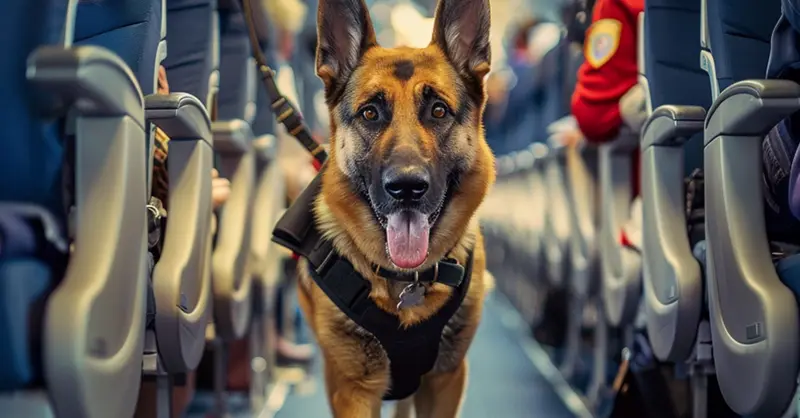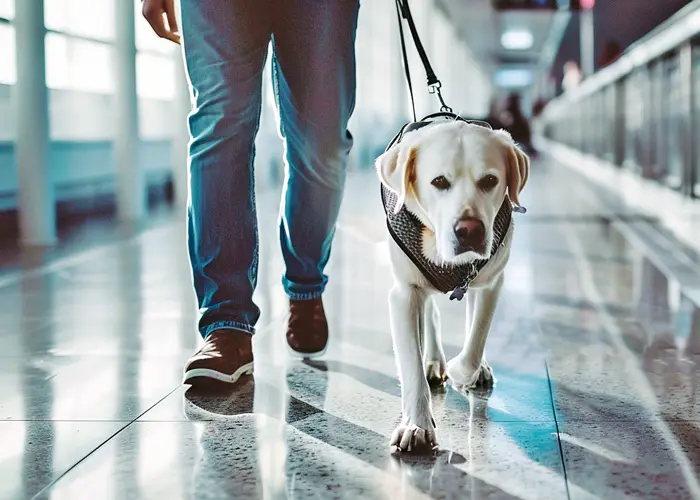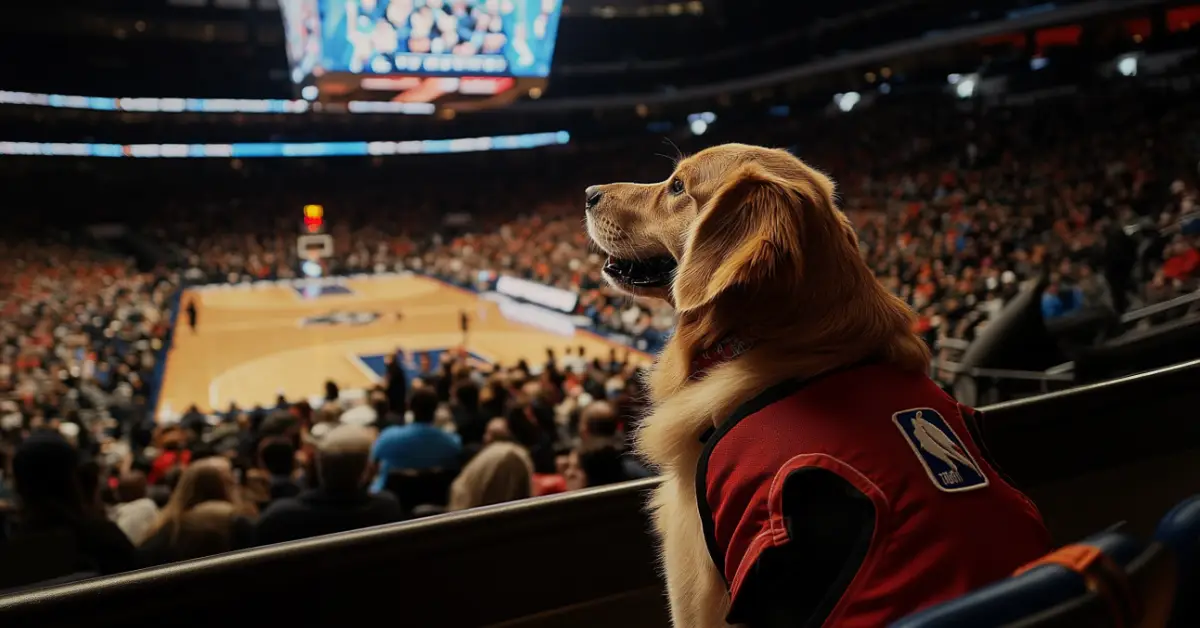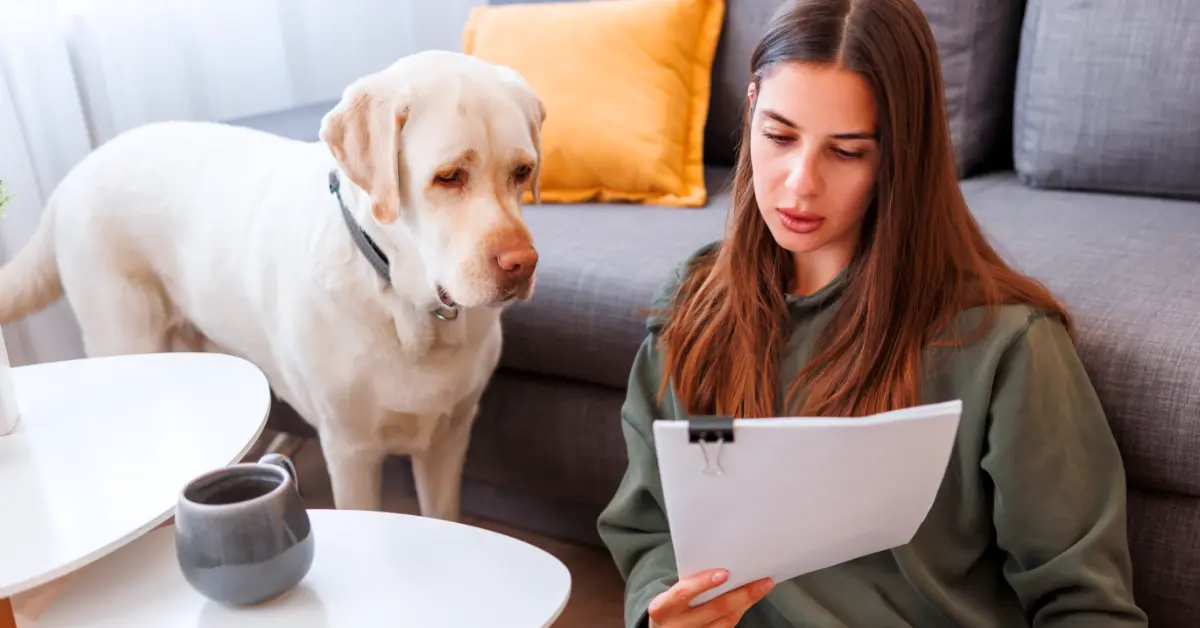How to Keep your Dog Calm While Flying

Keeping your dog calm during a flight requires preparation before the flight, like exercise and acclimation training, as well as learning some in-flight tactics. The stimulation at airports and airplanes can be stressful for dogs, but there are ways to manage their stress, which we’ll explain in this easy-to-follow guide.
Pre-Flight Preparation
1. Acclimate your dog
Unless you have a service dog, most airlines require that your dog be in a carrier during the flight. Starting several weeks before your flight, get your dog accustomed to being in the carrier.
You’ll want your dog to associate the carrier with being a cozy and comfortable place. Place your dog in the carrier and use treats and toys to help your dog develop positive associations with it. Make sure your dog has had ample time to get used to the way the carrier feels and smells.
Try to mimic the environment of being on a plane by placing the carrier under a chair and sitting over it. If your dog is not used to crowded environments like airports, take them to a busy public park or mall so they can get used to being around large numbers of people. Anxiety in dogs related to being around other people and dogs can be greatly reduced by socialization opportunities.
2. Consult your veterinarian
If your dog is especially prone to anxiety that leaves them in a catatonic state, ask your veterinarian about whether an anti-anxiety medication could help. Be aware, though, that veterinarians generally do not like prescribing sedatives for flights due to potential adverse reactions, so you’ll definitely want to chat with your veterinarian about this.
There are also homeopathic options available, like CBD, which one study showed can reduce stress in dogs. L-theanine is another natural supplement shown to help with stress sensitivity in dogs. If you’re flying with a service dog, you’ll want to ensure any medication or supplement you give your dog doesn’t interfere with their ability to perform tasks. Again, consult with your veterinarian before trying anything new.
If you decide to give your dog a medication or supplement, be sure to test it ahead of time. You don’t want to deal with any adverse reactions or surprises while you are at the airport or in the middle of a flight!
3. Book flights thoughtfully
There are some things you can do when planning your trip to help your dog. Limit the number of layovers your flight has. That will reduce the number of times you have to embark and disembark with your dog and the time your dog will need to spend in airports.
However, a layover might actually be helpful if you think your dog would feel better having a bathroom break and the chance to walk around for a bit. Also, consider booking a section with more legroom so you have more space (but keep in mind dogs are not allowed in exit rows). If your dog is anxious about flying, you definitely won’t want them to fly in cargo.
Make sure you have any paperwork your airline requires, like vet health certificates, ready ahead of time. If you’re traveling with a service dog or psychiatric service dog, you’ll need to complete the DOT’s Service Animal Air Transportation Form.
4. Pack items that will help soothe your dog
Bring the following items with you in your carry-on bag or a backpack or tote that’s easily accessible during the flight:
- A portable bowl for water.
- Treats that you know won’t upset your dog’s stomach.
- A leash and collar or harness.
- A familiar dog and blanket that smells like home.
- Bags and wipes in case your dog has an accident.
5. Plan your departure day carefully
Before arriving at the airport, take your dog for a long walk or play session so they can work off excess energy and get an opportunity to use the bathroom. Don’t overfeed your dog or introduce new foods prior to a flight. If they’re anxious about flying, it could leave an upset stomach.
Dogs can detect their owners’ stress, so make sure your flight day is planned with plenty of time to spare. You don’t want to panic when packing and rushing to the airport. Keep in mind how traffic to the airport will be at certain hours, and that lines at airports can be long during busy travel seasons. Leave yourself and your pooch with plenty of breathing room in your schedule.

During the Flight
1. Give continual reassurance
While at the airport and during the flight, stay calm and relaxed to help your dog feel the same.
Talk to your dog in a soothing voice occasionally to let them know everything is okay.
Stroke your dog slowly from head to tail to help them relax, and try gently massaging your dog’s shoulders and back. Each dog likes being touched in their own way. You know best how your particular dog likes to be petted and touched to make them feel relaxed.
Dogs will send signals when they are stressed or anxious, so you should constantly monitor your dog’s behavior for these signs. Here is what to look out for:
- Excessive Panting: If your dog is panting heavily despite the cabin being a comfortable temperature, this can be a sign of stress or anxiety.
- Shaking or Trembling: Noticeable shaking or trembling can indicate that your dog is feeling anxious or frightened.
- Whining or Barking: Excessive whining, barking, or howling, especially if your dog is usually quiet, can be a sign of distress.
- Pacing or Restlessness: If your dog is pacing within the carrier, moving around restlessly, or seems unable to settle, they are likely feeling anxious.
If you notice any of these signs, try using reassuring words, soothing touch, and distractions like a chew toy or treats to refocus their attention. Keep a close eye on your dog until it has calmed down.
2. Create a comfortable environment
There’s not a lot of space on a plane, but there are still things you can do to create a cozy environment for your dog. Provide your dog with the carrier it is now familiar with and its favorite blanket. Give your dog its favorite toy to chew on during the flight. Have some treats ready in a sealable bag and give them to your dog to create positive associations with air travel.
Try using a lavender-scented spray or diffuser, as one study showed it can have a calming effect on dogs (be sure to test this in advance, though). Dim lighting can also help create a soothing environment for your dog, so be sure to turn down the overhead lights and close the window shade.
About the Author: The writing team at Service Dog Certifications is made up of folks who really know their stuff when it comes to disability laws and assistance animals. Many of our writers and editors have service dogs themselves and share insights from their own experiences. All of us have a passion for disability rights and animals.
Latest Posts

Dangerous Materials Hiding in Your Dog Products
Jake’s German Shepherd began developing strange rashes around his collar. Three vet visits later, they figured out the leather was treated with chromium — a chemical that irritates sensitive skin. Jake had no idea his dog’s collar contained industrial chemicals. Most dog owners don’t know what goes into the products they buy. Many companies use […]

Read More

Can You Bring a Service Dog to a Basketball Game?
Yes, you absolutely can bring your service dog to basketball games. Whether you’re heading to your local high school tournament, a packed college rivalry game, or splurging on NBA tickets, the Americans with Disabilities Act protects your right to be accompanied by your service dog anywhere the public can go. When you arrive, venue employees […]

Read More

Best Pet Health Insurance Providers
If you own a pet, you know how important — and expensive — vet care can be. One way to offset those costs is to purchase pet health insurance. Like typical health insurance, pet insurance is available at many price points, and can cover all, most, or only some of your vet-related costs. It can […]

Read More